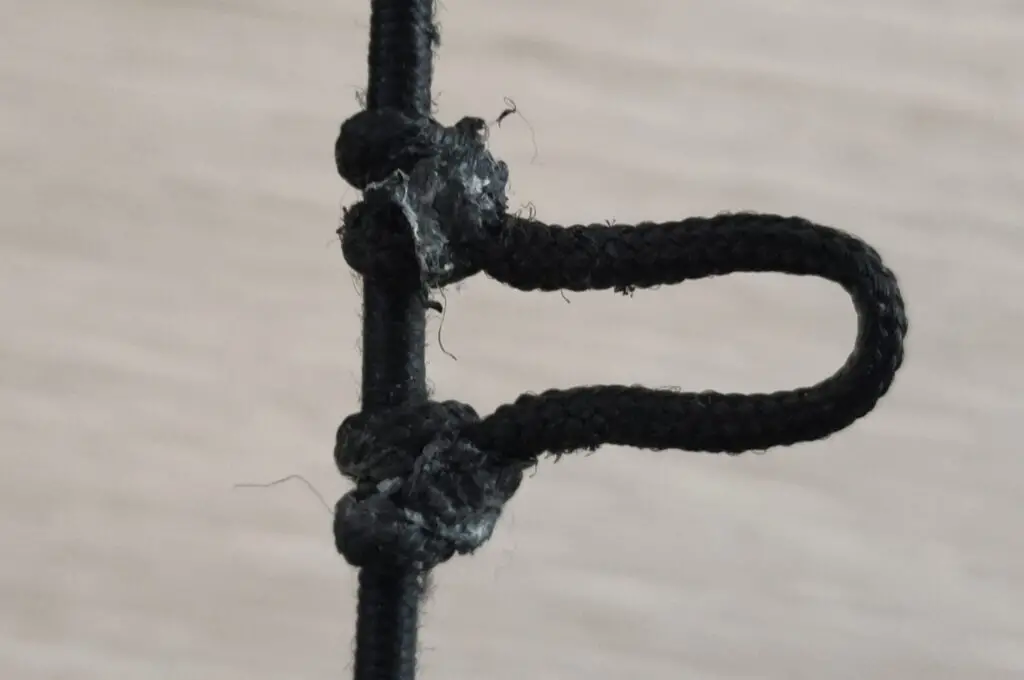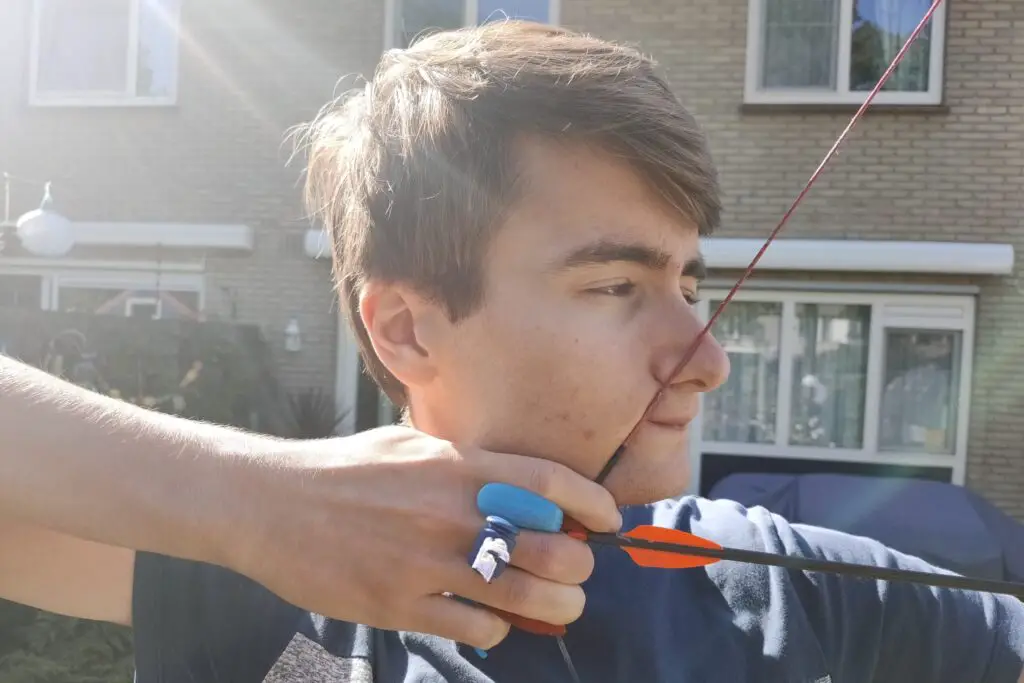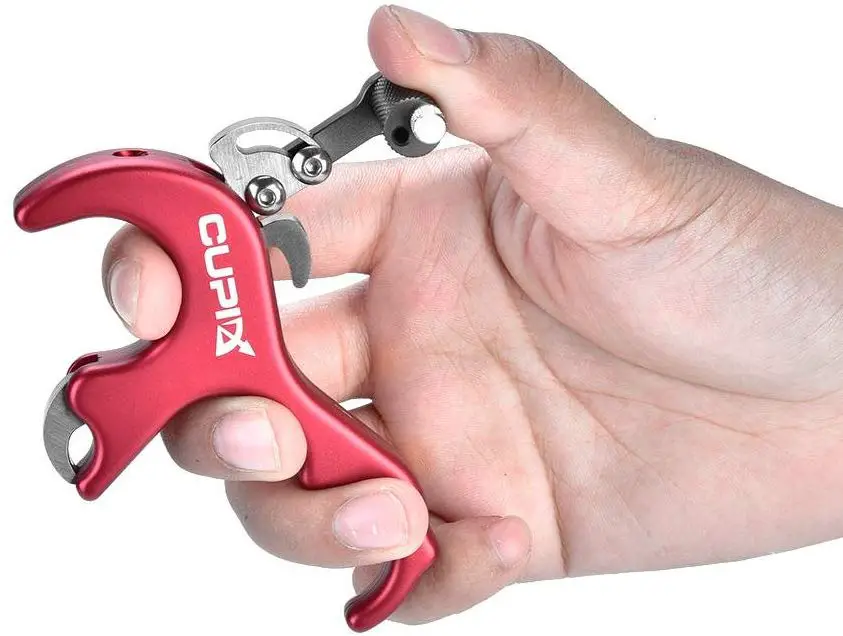Almost every compound archer uses a D-loop nowadays. But if you look at pictures from 30 years ago, you see that everyone clips the release directly on the string. Therefore, you might wonder whether a D-loop is unnecessary. Maybe you like to minimize the number of doodads on your bow or maybe you don’t have a D-loop ready. Therefore, we discuss in this article, whether it’s necessary to use a D-loop. Here is a summary in case you are in a hurry:
You can use a release without a D-loop. However, the D-loop makes your bow more forgiving and allows you to be more accurate overall. Additionally, it might be difficult finding the right nocking points and release since it’s an unusual shooting style nowadays.
In this article, I will first discuss some reasons why some archers don’t like to use a D-loop. In the next section, I will explain the benefits of a D-loop. At the end of this article, I will give some tips on shooting a compound bow without a D-loop and explain how you can easily make a D-loop yourself.
Why you might want to shoot without a D-loop
Alright, let’s get the obvious reason out of the way first. Maybe you want a D-loop but don’t have the means to do so. In those cases, you might want to shoot without a D-loop until you get a new one. That is a solid reason in my opinion, but you have to make sure that you have the right setup to do so. We will discuss that in more detail in this section.
There are, however, also some archers that are just fiercely against D-loops. Although this is a shrinking minority, I still want to discuss their reasons for hating a D-loop.
Longer draw length
The first major disadvantage of the D-loop is that it decreases your draw length. Although it’s only about an inch, it’s still a con. A longer draw length creates a longer power stroke and increases the speed of the arrow. In general, this difference is quite minor, but when arrow speed is important for your purposes, it might be worth considering.
For most archers, this will not be a big deal, however. Even most hunters are using a D-loop while arrow speed is vitally important for them.


The D-loop can come loose
I believe this is primarily a concern for shooters that haven’t used a D-loop before. Some archers are afraid that the D-loop can come loose while drawing the bow. Technically this can happen. But I have never experienced it, even though my D-loop knot is quite sloppy. If you tie a D-loop knot correctly it will be strong and never come loose.
But still, I must admit that I am always very cautious when drawing the bow. If you draw directly to your face, it can hurt a lot when the bow goes off. But I am more afraid of my release going of than anything happening to my D-loop. I had a few times that my release wasn’t clipped on correctly. Therefore, the release went off after the first inch of the draw.
I have never hit my head because of a misfire. But if you draw correctly that shouldn’t happen even if everything goes wrong. You should always draw away from your face. Once you are at full draw, you can go to your anchor point. Sadly, not all archers have learned this, which can cause major injuries.

It’s easier to attach the release
Every time you shoot your compound bow, you must attach the release to your string or D-loop. A D-loop is flexible and can flex when you try to attach your release. Since the string is under tension, it stays always perfectly in place.
Therefore, it’s often easier to attach your release to a string than to a D-loop. For archers that practice archery as a sport, the difference might not matter. But for hunters, it’s important to have an efficient draw. If you spend more time preparing your bow, your pray might run away in the meantime. Time spend finding your D-loop might be better spent aiming at your target.
It might seem unnecessary
Some archers are all about simplicity. They don’t like to use any doodads that are not strictly necessary. And yes, it’s not strictly necessary to use a D-loop. A D-loop has some great advantages, but you don’t need it to shoot with a release.
But compound archery isn’t about simplicity. The mechanical release, the cams, and the sight all make archery more complicated. They all help improve your accuracy of course, but it’s not strictly necessary. So, I think if you like simplicity, maybe traditional archery would be more up your alley.
I think shooting without a D-loop doesn’t make a lot of sense. It’s one of the many tools that make compound archery easier and more accurate. But of course, you might have a different opinion.
Why you should shoot with D-loop
Although there are some disadvantages of D-loops, there are a lot more advantages. That’s why almost all archers are shooting with a D-loop nowadays. I will discuss the advantages of a D-loop one by one.
It prevents arrow pinching
When you don’t have a D-loop, you have to attach the release under or above the arrow. From the point where you attach the release, the string will start to form a steep angle to the cams. This angle can cause your nocking points to rub up to the arrow. This is what we call arrow pinch, which can severely hurt your accuracy.
With a D-loop, the arrow is kept in a vertical position. Because the D-loop is attached both below and under the arrow, there is an even amount of force. Therefore, you won’t experience arrow pinching with a D-loop.

It’s easier to stay consistent
In recurve archery, one of the biggest concerns is the consistency of your release. When you use a mechanical release, like most compound archers, this isn’t an issue. But if you don’t use a D-loop, you must make sure that you place it consistently at the same height of the string.
Even the slightest amount of difference can hurt your accuracy. Since you can attach the release anywhere on the string, you can easily change the position between shots. With a D-loop, it’s easy to stay consistent. The release will center itself on the D-loop. Therefore, you don’t have to think about consistency at all.
It prevents you from damaging the serving
Archers that place the release directly on the string, will wear out their serving much faster. With a mechanical release, all the force is centered over a small area. Therefore, abrasion can quickly scuff up the serving. This is made worse by the heavy draw weight of most compound bows and the steep draw angle of short frame compound bows.
Of course, D-loops will also experience abrasion. But since D-loops are made of stronger materials, it will take a lot longer for it to need replacement.
Even when your D-loop needs replacing, it’s much easier to replace than your middle serving. Replacing your middle serving will take at least 30 minutes. Replacing your D-loop will only take 2 or 3 minutes.
In my experience, however, the middle serving needs replacing faster than the D-loop. The nock of the arrow also wears down the serving. Since you must remove your D-loop whenever you replace the serving, I have never replaced only the D-loop.
You can pop the arrow off the string
When your nocks are too small, your release might slip over them and pop up the arrow. When this happens, you must let down the bow and start over. This can’t happen when you shoot with a D-loop.
It’s safer
One of the scariest things that can happen to your compound bow is a derailment. This happens when you twist the string and bow at the same time. Although it’s not something that happens often, it’s more likely to happen when you attach your release directly to the string.
When you twist your release while it’s clipped on a D-loop, the D-loop will start to twist. But if you twist the release when it’s clipped on to the string itself, the string will start to twist. Therefore, you must be very careful that you don’t twist the string with your release.
Most caliper releases are free swiveling, which prevents this issue. But most thumb and hinge releases aren’t, which makes it more dangerous to shoot with these kinds of releases.
It limits your release choice
Most releases these days are made to be shot with a D-loop since it’s the standard right now. Some manufacturers even mention specifically that their release should only be used in combination with a D-loop.
Some thumb releases but especially hinge releases tend to have issues when you shoot them without a D-loop. They might not work correctly when clipped onto the string or have a higher failure rate. Therefore, you should never use a release on a string that has these warnings.
Tips for shooting without a D-loop
If I have convinced you to shoot with a D-loop instead, please read the next section. But if you still want to shoot without a D-loop please read these tips. Years ago, when every archer shot without a D-loop all equipment was designed for this shooting style. But now the D-loop has become the standard, it will take some additional consideration.
Get a long frame compound bow
The steeper the angle of the string the bigger the arrow pinching issue will be. You can decrease the angle of the string in two ways:
- Reducing the draw length
- Placing the cams farther away from each other.
Of course, the first point isn’t an option. But we can do something about the second point. On long frame compound bows, the cams are farther apart. Therefore, these bows decrease the issue of arrow pinching.
If you have a short draw length (26 inches or lower) a short frame compound bow might work as well. But if you have a long draw weight, I would seriously consider a long frame compound bow.
Get special nocking points
As I mentioned earlier, if your nocking points are too small, your release will interfere with the arrow. Therefore, you should make sure that your nocking points are large enough to retain your release. Luckily, there are special nocking points that you can use when you shoot without a release. Make sure to do your research and check whether your nocking points are suitable for your shooting style.
Be careful with your release
Some releases don’t work well when shot directly from the string. Therefore, you should check whether your release is suitable for this. Some manufacturers specifically mention that you shouldn’t use their release directly on the string.
Get high-quality serving
Your release will wear out the serving a lot faster than when you shoot your bow with your fingers. When you shoot a bow with your fingers, the pressure is more evenly distributed. Additionally, your fingers are a lot softer than the sear mechanism of your release.
Therefore, you should invest in durable serving if you don’t want to replace it often. Going for cheaper options might cause a lot of frustrations in the long run.
Make sure that you don’t twist the string!!!
In the video earlier in the article you can see what happens if you twist the string. The bow derails, which can cause a lot of damage to your bow. Especially when you are using a release without a free rotating sear mechanism, you must be careful.
Most wrist releases can safely be used on the string directly because you can’t twist the string. But especially with handheld thumb releases, you have to be very careful.


Making a D-loop, quick and dirty
Maybe you want to shoot with a D-loop but don’t know how to tie one or don’t have the right materials handy. Although it’s best to make a D-loop from purpose-made materials, you can also make a D-loop from other materials.
To make your own D-loop, you need the following materials:
- A piece of rope
- Stanley blade or box cutter
- A lighter
It’s best to have a piece of rope that isn’t stretchy because this will make your D-loop longer. If you have to use stretchy material, such a paracord, make sure to tie the D-loop a bit smaller. It might take a few tries using stretchy materials, but it still works. See the video below to see how to tie a D-loop.
Continue reading
Continue reading by clicking on one of the articles below:
Final words
Some archers believe that there is one technique or setup that everyone should follow. I don’t share that opinion, but I do think that some gear or techniques have a clear advantage. This is exactly how I feel about D-loops. They are a great invention to make compound archery easier. But if you don’t want to use a D-loop there is nothing wrong with that. It’s only getting more difficult today because basically everything is designed about shooting with a D-loop.
I hope that my article helped you make an informed decision on whether you want to shoot with a D-loop or not. I tried to keep it as objective as possible. If you have any additional advantages of shooting without please let me know.
If you have any questions, comments, or feedback, please let me know in the comment section down below. I will respond as soon as possible and send you an email with my reply.
Tim van Rooijen
For as long as I can remember, I have always been fascinated by archery. First due to its historic significance but later because I like being outdoors. With this blog, I share my knowledge about Archery and how you can improve your shot. More about author…

